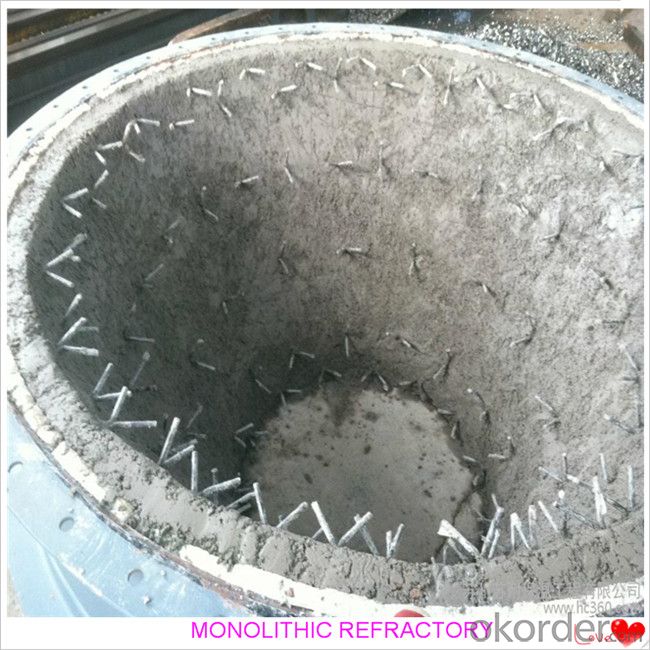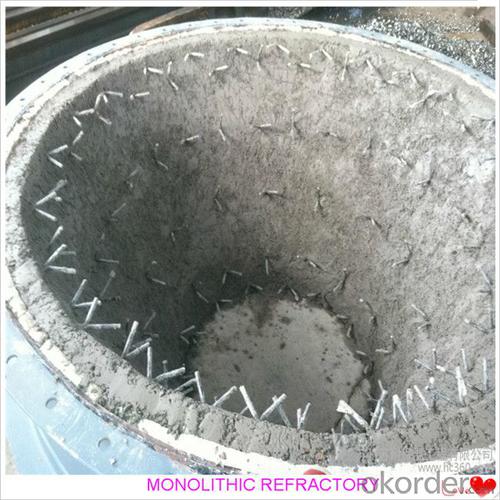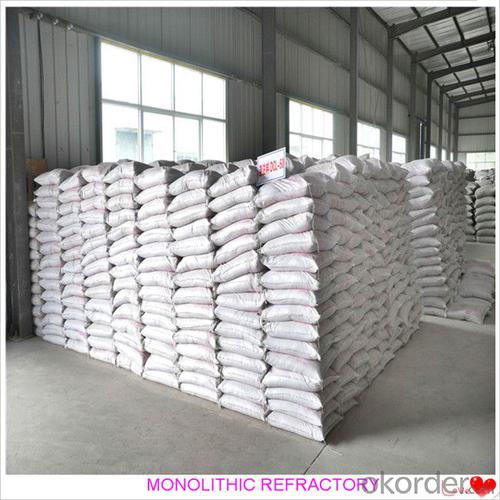Monolithic Refractories for Iron and Steel Industry:Castable Refractory for Fireplace and Industrial Furnace
- Loading Port:
- China main port
- Payment Terms:
- TT or LC
- Min Order Qty:
- 1000 kg
- Supply Capability:
- 3000000 kg/month
OKorder Service Pledge
OKorder Financial Service
You Might Also Like
Castable Refractory for Fireplaces and Industrial Iron and Steel Furnaces
Product Description:
Gunning castable is manufactured according to international standards. The product is famous for its excellent abrasion resistance and low thermal conductivity. Further, these can be provided in different specifications as required by clients. Gunning castables use high purity raw materials and additives as the main material, and are made with superfine powder adding technology.
Product Features:
The material has excellent structural stability and air tightness, and has high physical and chemical properties, and also excellent working ability. If should be used with the same material products.
Product Applications:
Widely used in various kiln linings, such as boilers, blast furnace hot blast stoves, heating furnaces, ceramic kilns, heat treatment furnaces, incinerators, re-circulating fluidized bed furnaces and chemical industry and construction industry furnaces.
Product Specifications:

Product Images:




FAQ:
Q1: Why buy Materials & Equipment from OKorder.com?
A1: All products offered by OKorder.com are carefully selected from China's most reliable manufacturing enterprises. Through its ISO certifications, OKorder.com adheres to the highest standards and a commitment to supply chain safety and customer satisfaction.
Q2: How do we guarantee the quality of our products?
A2: We have established an advanced quality management system which conducts strict quality tests at every step, from raw materials to the final product. At the same time, we provide extensive follow-up service assurances as required.
- Q: How do monolithic refractories improve the efficiency of ladle and tundish preheating stations?
- Monolithic refractories improve the efficiency of ladle and tundish preheating stations by providing excellent insulation properties and high thermal conductivity. This allows for better heat retention and transfer, resulting in faster and more efficient preheating of ladles and tundishes. Additionally, monolithic refractories offer improved resistance to thermal shocks and erosions, leading to longer service life and reduced downtime for maintenance and replacement.
- Q: How do monolithic refractories withstand high temperatures in iron and steel production?
- Monolithic refractories are able to withstand high temperatures in iron and steel production due to their composition and unique properties. These refractories are made from a single, continuous material, which eliminates the need for joints or seams that could weaken under extreme heat. Additionally, they have high thermal conductivity and low thermal expansion, allowing them to effectively absorb and distribute the intense heat in the production process without cracking or breaking. Furthermore, monolithic refractories are highly resistant to chemical corrosion and erosion, which is crucial in the harsh environment of iron and steel production. Overall, the combination of these factors enables monolithic refractories to withstand the extreme temperatures involved in iron and steel production.
- Q: How are monolithic refractories repaired or replaced in iron and steel facilities?
- Monolithic refractories in iron and steel facilities are repaired or replaced through a process known as hot repair or hot gunning. This involves using specialized equipment to heat the damaged refractory material and remove it. The area is then prepared for new refractory installation, which is done by either shotcreting or gunning the new material onto the surface. This method allows for quick repairs and replacements, minimizing downtime and ensuring the efficiency and safety of the facility.
- Q: What are the specific requirements of monolithic refractories for blast furnace applications?
- To withstand the harsh conditions and high temperatures within a blast furnace, monolithic refractories used in these applications have specific requirements. These requirements encompass thermal stability, high strength, chemical resistance, erosion and abrasion resistance, low porosity, dense structure, and easy installation. Firstly, monolithic refractories must possess excellent thermal stability to endure the extreme temperatures encountered in blast furnaces. They should be able to resist thermal shock and maintain their physical and chemical properties even at high temperatures. Secondly, blast furnace conditions subject refractory linings to significant pressure and mechanical stress. As a result, monolithic refractories need to possess high strength and resistance to mechanical wear in order to withstand the weight of the burden and the movement of materials inside the furnace. Furthermore, blast furnace environments are highly corrosive due to the presence of molten metals, slag, and gases. Therefore, monolithic refractories should exhibit exceptional chemical resistance to prevent chemical reactions with these substances, which could lead to refractory degradation. Additionally, the materials being processed in a blast furnace can cause erosion and abrasion, resulting in wear of the refractory lining. Monolithic refractories used in blast furnaces should be able to withstand these erosive and abrasive forces, ensuring a longer service life. Moreover, blast furnace refractories should have low porosity to minimize the penetration of molten materials and gases. This is crucial as their penetration can cause refractory spalling and damage. Additionally, low porosity helps maintain the refractory lining's thermal stability and overall performance. Furthermore, the refractory lining in a blast furnace should have a dense structure to prevent the penetration of molten slag and metal, which could lead to refractory failure. A dense structure also aids in the refractory's heat insulation properties. Lastly, blast furnace refractories need to be easily installed and repaired due to frequent maintenance and repair requirements. Monolithic refractories offer the advantage of easy installation as they can be cast, gunned, or sprayed onto the refractory surface. This allows for quick repairs and reduced downtime. Overall, meeting these specific requirements ensures the durability and efficiency of the refractory lining, ultimately leading to improved blast furnace performance.
- Q: What are the key properties of monolithic refractories?
- Monolithic refractories, which lack a definite form like bricks or tiles, are a type of refractory material. They are typically composed of a mixture of aggregates, binders, and additives that can be easily molded and installed in various industrial applications. The main characteristics of monolithic refractories include: 1. Exceptional heat resistance: Designed to endure extremely high temperatures, monolithic refractories are suitable for industries such as steel, cement, glass, and petrochemicals. They can maintain their strength and structural integrity even at temperatures exceeding 3000 degrees Fahrenheit. 2. Ability to withstand thermal shock: Monolithic refractories possess the capacity to resist sudden temperature changes, which can cause cracking or damage to the refractory. This property is crucial in environments where rapid heating or cooling occurs, such as furnaces or kilns. 3. Resistance to chemical attack: Monolithic refractories display excellent resistance to corrosion from molten metals, slag, gases, and other harsh substances. This makes them ideal for environments where contact with acidic or alkaline materials is common. 4. Low porosity: Monolithic refractories have low porosity, meaning they have a high density and are less permeable to gases and liquids. This property ensures that molten metals or corrosive substances cannot easily penetrate the refractory, contributing to its longevity and performance. 5. Easy installation and repair: Unlike traditional refractory materials like bricks, monolithic refractories can be easily molded and installed in various shapes and sizes. They can be applied using techniques such as spraying, casting, or ramming, allowing for faster installation and reduced downtime. Additionally, if any damage occurs, they can be easily repaired or patched. 6. Strong mechanical strength: Monolithic refractories possess sufficient mechanical strength to endure the stresses and pressures encountered during their service life. This guarantees their structural integrity, even under high load conditions. Overall, the versatile and reliable properties of monolithic refractories make them an excellent choice for a wide range of industrial applications that require resistance to high temperatures, chemicals, and thermal shock.
- Q: What are the typical applications of monolithic refractories in the iron and steel industry?
- Monolithic refractories are widely used in various applications within the iron and steel industry. These refractories, which are made of a single material, offer several advantages such as ease of installation, resistance to thermal shock, and excellent resistance to chemical attacks. Here are some typical applications of monolithic refractories in the iron and steel industry: 1. Blast Furnace: Monolithic refractories are used in the lining of blast furnaces, where they are subjected to extreme temperatures and chemical reactions. They provide thermal insulation, prevent erosion, and resist the corrosive effects of molten iron and slag. 2. Ladles and Tundishes: Monolithic refractories are used to line ladles and tundishes, which are vessels used for transporting and transferring molten metal. These refractories offer good thermal insulation and resistance to erosion and chemical attack, ensuring the integrity of the vessels. 3. Steelmaking Converters: Monolithic refractories are utilized in converters, which are used in the steelmaking process to convert molten pig iron into steel. These refractories provide protection against the high temperatures and aggressive chemical environments encountered during the process. 4. Electric Arc Furnaces (EAF): Monolithic refractories are used to line the walls and roofs of EAFs, which are used to melt scrap steel for recycling. These refractories offer excellent thermal insulation, resistance to slag erosion, and thermal shock resistance, ensuring the longevity and efficiency of the furnace. 5. Continuous Casting: Monolithic refractories are employed in the continuous casting process, where molten steel is solidified into a continuous slab or billet. These refractories line the walls and floors of the casting molds, providing thermal insulation and resistance to chemical attack from the molten steel. 6. Reheating Furnaces: Monolithic refractories are used in reheating furnaces, which are used to heat steel billets or ingots prior to further processing. These refractories provide insulation, resist high temperatures, and ensure uniform heating of the metal. Overall, monolithic refractories play a crucial role in the iron and steel industry by providing reliable and durable linings in various applications. Their ability to withstand extreme temperatures, chemical attacks, and thermal shocks makes them indispensable for maintaining the integrity and efficiency of the production processes.
- Q: What are the advantages of using plastic refractories in the iron and steel industry?
- There are several advantages of using plastic refractories in the iron and steel industry. Firstly, plastic refractories have excellent thermal shock resistance, which means they can withstand rapid changes in temperature without cracking or breaking. This is crucial in the iron and steel industry where the materials are exposed to extreme heat during the manufacturing process. Secondly, plastic refractories have good workability and can be easily shaped and molded to fit various complex shapes and sizes of furnaces, ladles, and other equipment used in the industry. This makes them highly versatile and adaptable to different production requirements. Additionally, plastic refractories have excellent resistance to chemical attacks from molten metals and slags. They can withstand the corrosive nature of these materials and maintain their structural integrity, ensuring longer service life and reducing maintenance costs. Lastly, plastic refractories have good bonding properties, allowing them to adhere well to existing refractory linings. This helps to extend the lifespan of the overall refractory system and reduce the need for frequent repairs or replacements. Overall, the advantages of using plastic refractories in the iron and steel industry include thermal shock resistance, workability, chemical resistance, and good bonding properties, making them a preferred choice for lining and repairing furnaces and other equipment in this industry.
- Q: What are the advantages of using monolithic refractories in electric arc furnaces?
- Using monolithic refractories in electric arc furnaces offers several advantages. Firstly, their excellent thermal shock resistance allows them to withstand rapid temperature changes without cracking or deteriorating. This ensures the longevity and efficiency of the furnace. Secondly, monolithic refractories have superior corrosion resistance. They are specifically designed to resist chemical attack from aggressive slag compositions, providing long-lasting protection against corrosion. Additionally, monolithic refractories offer great flexibility in terms of installation. Unlike brick linings, they can be easily applied as a liquid or paste, allowing for faster and more efficient installation. This reduces downtime during maintenance or repairs and allows for customized linings to be easily created. Moreover, monolithic refractories have excellent thermal conductivity, allowing for efficient heat transfer within the furnace. This results in optimal energy use and minimized heat losses, leading to reduced operating costs and increased productivity. Furthermore, monolithic refractories have a high refractoriness, meaning they can withstand extremely high temperatures without deformation or failure. This is crucial for the safe and efficient operation of electric arc furnaces. In conclusion, the advantages of monolithic refractories in electric arc furnaces include their thermal shock resistance, corrosion resistance, ease of installation, high thermal conductivity, and exceptional refractoriness. These properties contribute to improved furnace performance, increased productivity, reduced operating costs, and extended furnace life.
- Q: What are the challenges in repairing and maintaining monolithic refractories?
- One of the challenges in repairing and maintaining monolithic refractories is the difficulty in identifying and accessing damaged areas. Monolithic refractories are typically used in complex and intricate structures, making it challenging to locate and reach areas that require repair or maintenance. Another challenge is the high temperatures involved, as monolithic refractories are often exposed to extreme heat. This requires specialized expertise and equipment to ensure safe and effective repairs. Additionally, the composition and application of monolithic refractories can vary, making it essential to understand the specific type being used in order to perform accurate repairs and maintenance. Overall, the challenges lie in the complexity of the structures, the extreme temperatures, and the need for specialized knowledge and tools.
- Q: What are the considerations for selecting monolithic refractories for reheating furnaces?
- When choosing monolithic refractories for reheating furnaces, there are several important factors to consider: 1. Temperature requirements: It is crucial to select monolithic refractories that can withstand the desired temperature range without experiencing significant thermal degradation or failure. These refractories must have a high refractoriness to maintain their structural integrity under these conditions. 2. Thermal shock resistance: Reheating furnaces often undergo rapid temperature changes, which can cause cracking and spalling. Therefore, it is essential to choose monolithic refractories with good thermal shock resistance to prevent premature failure of the lining. 3. Mechanical strength: The monolithic refractories should have sufficient mechanical strength to withstand the stresses caused by the weight of the materials being heated and any mechanical movements within the furnace. This helps to prevent deformation or structural failure of the refractory lining. 4. Chemical compatibility: The refractories must be chemically compatible with the atmosphere and process gases in the reheating furnace. They should resist chemical attacks from the gases or any corrosive substances generated during the reheating process. This ensures a longer service life for the refractory lining. 5. Abrasion resistance: Reheating furnaces often handle abrasive materials, so it is important to choose monolithic refractories with good abrasion resistance. This helps to minimize wear and extend the lifespan of the lining. 6. Ease of installation: Monolithic refractories offer advantages in terms of ease of installation compared to traditional brick refractories. However, it is important to consider the installation method and time required for the chosen monolithic refractory. Some monolithic refractories may require specialized equipment or techniques for installation. 7. Cost-effectiveness: Although the initial cost of monolithic refractories may be higher than traditional brick refractories, their longer service life and ease of installation can result in overall cost savings. Therefore, it is crucial to assess the cost-effectiveness of different monolithic refractory options when selecting the most suitable one for the reheating furnace. By considering these factors, you can make an informed decision when choosing monolithic refractories for reheating furnaces, ensuring optimal performance, durability, and cost-effectiveness.
Send your message to us
Monolithic Refractories for Iron and Steel Industry:Castable Refractory for Fireplace and Industrial Furnace
- Loading Port:
- China main port
- Payment Terms:
- TT or LC
- Min Order Qty:
- 1000 kg
- Supply Capability:
- 3000000 kg/month
OKorder Service Pledge
OKorder Financial Service
Similar products
Hot products
Hot Searches
Related keywords































